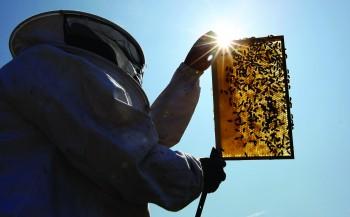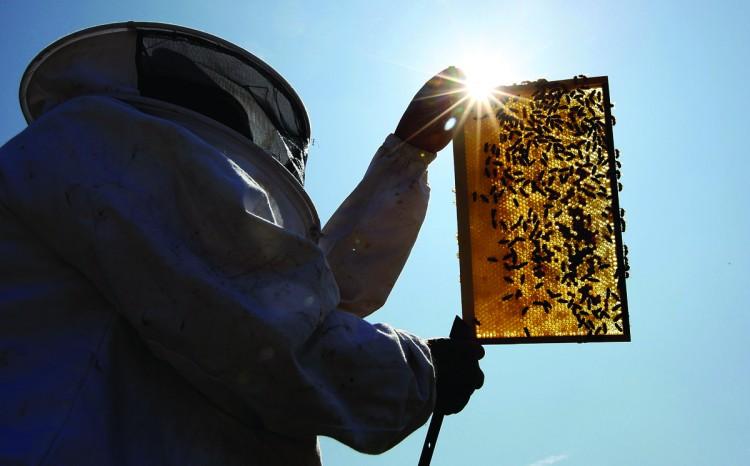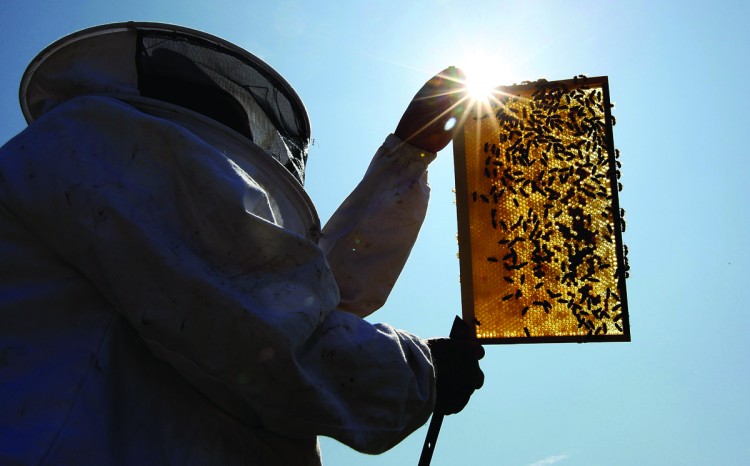A national bee diagnostic centre is set to open in northern Alberta this fall in response to the insect’s increasing mortality rates. This will be Canada’s first laboratory dedicated to investigating honeybee deaths.
In an alarming trend, bee colony losses in Canada have risen from average levels of 5-15 percent to over 30 percent since 2006. A worldwide phenomenon, the increase in bee mortality started in Europe and North America, and later emerged in Asia and Africa.
Causes are uncertain, but have been linked to a combination of factors including pathogens, immunodeficiencies, mites, fungi, pesticides, improper beekeeping practices, malnutrition and Colony Collapse Disorder—a phenomenon where worker bees from a hive or colony abruptly disappear.
The Centre for Research and Innovation at Grande Prairie Regional College (GPRC) will oversee the new bee diagnostic centre at the Beaverlodge Research Farm.
Director Bruce Rutley says the centre will investigate and try to pinpoint specific causes of bee mortality in order to identify potential solutions.
“We [currently] do not have a very robust method of identifying exactly what’s going on, and that’s why we want to set up a centre using the most robust techniques that we can, which are molecular DNA-based techniques,” he said.
Alberta is the leading honey-producing province in Canada, responsible for almost 40 percent of total production, 20 percent of which comes from the northern Peace region. According to the Canadian Honey Council, over 80 percent of honey production is generated from the Prairie Provinces.
The GPRC is an ideal host for the research centre because it already offers a bee-keeper technician training program, Beaverlodge is the home of Agriculture and Agri-food Canada’s apiculture research program, and the Peace is a major honey-producing area.
A high bee mortality rate is a major concern since their pollinating activities are crucial to the production of approximately one-third of the foods eaten worldwide, as well as many flowering plants.
Rutley says the combination of high death rates and a decrease in beekeeping as a profession due to its questionable viability has a “compounding negative effect” on the future of food security.
Nosema a growing problem
Lee Townsend, vice-president of the Alberta Beekeepers Commission, says the loss of bee colonies across Canada has been devastating.
“In the past four years we’ve seen losses of anywhere between 30 percent and 100 percent across the province, and it’s not isolated to Alberta—it’s also happened in other regions of the country as well.”
Townsend says an ailment that has afflicted Alberta’s bees this year is Nosema, a fungus that disrupts the intestinal tract and is passed down to offspring. Nosema is especially difficult to combat because, although treatments inoculate the bees, they do not kill the pathogen itself.
“Nosema levels just aren’t falling and responding to the controls that we have used in the past,” says Townsend.
He is doubtful that mortality rates will drop, and says beekeepers are now doing their own research to try and limit the losses of honeybees.
“A lot of beekeepers have their own little research labs in their own home-grown facilities,” he says. “We’re having to do a lot more bee-work all the time and it’s just a matter of beekeepers accepting that and following through on it.”
Townsend says the provincial government and industry associations have helped to provide resources and education for beekeepers on how to test for, inspect, treat, and control diseases, but more support is needed.
He hopes that the beekeeping community in Alberta can work closely with the new diagnostic centre in order to pool resources and knowledge and have it all in one place.
“There’s definitely more work that needs to be done. We’re always dealing with new and emerging problems—and our current existing ones are still a problem for us,” he says.
“We are a smaller industry, but we contribute a great amount to all forms of agriculture, and even life, in Canada.”
In an alarming trend, bee colony losses in Canada have risen from average levels of 5-15 percent to over 30 percent since 2006. A worldwide phenomenon, the increase in bee mortality started in Europe and North America, and later emerged in Asia and Africa.
Causes are uncertain, but have been linked to a combination of factors including pathogens, immunodeficiencies, mites, fungi, pesticides, improper beekeeping practices, malnutrition and Colony Collapse Disorder—a phenomenon where worker bees from a hive or colony abruptly disappear.
The Centre for Research and Innovation at Grande Prairie Regional College (GPRC) will oversee the new bee diagnostic centre at the Beaverlodge Research Farm.
Director Bruce Rutley says the centre will investigate and try to pinpoint specific causes of bee mortality in order to identify potential solutions.
“We [currently] do not have a very robust method of identifying exactly what’s going on, and that’s why we want to set up a centre using the most robust techniques that we can, which are molecular DNA-based techniques,” he said.
Alberta is the leading honey-producing province in Canada, responsible for almost 40 percent of total production, 20 percent of which comes from the northern Peace region. According to the Canadian Honey Council, over 80 percent of honey production is generated from the Prairie Provinces.
The GPRC is an ideal host for the research centre because it already offers a bee-keeper technician training program, Beaverlodge is the home of Agriculture and Agri-food Canada’s apiculture research program, and the Peace is a major honey-producing area.
A high bee mortality rate is a major concern since their pollinating activities are crucial to the production of approximately one-third of the foods eaten worldwide, as well as many flowering plants.
Rutley says the combination of high death rates and a decrease in beekeeping as a profession due to its questionable viability has a “compounding negative effect” on the future of food security.
Nosema a growing problem
Lee Townsend, vice-president of the Alberta Beekeepers Commission, says the loss of bee colonies across Canada has been devastating.
“In the past four years we’ve seen losses of anywhere between 30 percent and 100 percent across the province, and it’s not isolated to Alberta—it’s also happened in other regions of the country as well.”
Townsend says an ailment that has afflicted Alberta’s bees this year is Nosema, a fungus that disrupts the intestinal tract and is passed down to offspring. Nosema is especially difficult to combat because, although treatments inoculate the bees, they do not kill the pathogen itself.
“Nosema levels just aren’t falling and responding to the controls that we have used in the past,” says Townsend.
He is doubtful that mortality rates will drop, and says beekeepers are now doing their own research to try and limit the losses of honeybees.
“A lot of beekeepers have their own little research labs in their own home-grown facilities,” he says. “We’re having to do a lot more bee-work all the time and it’s just a matter of beekeepers accepting that and following through on it.”
Townsend says the provincial government and industry associations have helped to provide resources and education for beekeepers on how to test for, inspect, treat, and control diseases, but more support is needed.
He hopes that the beekeeping community in Alberta can work closely with the new diagnostic centre in order to pool resources and knowledge and have it all in one place.
“There’s definitely more work that needs to be done. We’re always dealing with new and emerging problems—and our current existing ones are still a problem for us,” he says.
“We are a smaller industry, but we contribute a great amount to all forms of agriculture, and even life, in Canada.”






